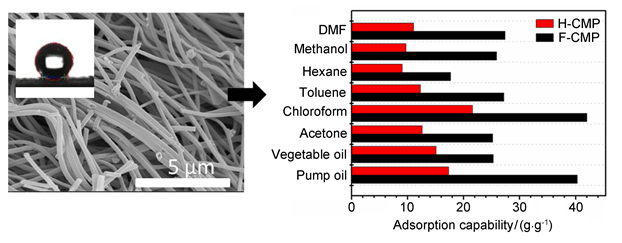摘要/Abstract

共轭微孔聚合物由于其高的比表面积、优良的物理化学稳定性、多样的合成方法以及沿分子骨架延伸的共轭结构等特点,近几年得到广泛关注和快速发展.本工作以1,3,5-三氟-2,4,6-三碘苯作为含氟单体与1,3,5-三乙炔基苯通过Sonogashira偶联反应聚合得到含氟共轭微孔聚合物F-CMP.通过把氟原子引入到共轭微孔聚合物骨架中,F-CMP显示出良好的疏水性能,与水的接触角达到145°.得益于良好的疏水性能和适宜的孔隙结构,相比于骨架结构相似的不含氟共轭微孔聚合物(H-CMP),F-CMP对油和有机溶剂的吸附量得到大幅提高,且显示出高的吸附速率和良好的吸附循环性.
关键词: 共轭微孔聚合物, 氟掺杂, 吸附材料
Water pollution arising from ever-growing domestic sewage and industrial organic pollutants has caused severe environmental and ecological problems in many parts of the world. It is urgent to seek appropriate ways to resolve oily wastewater and organic solvent pollution. Currently, physical adsorption is considered to be one of the most important methods to eliminate the oil contaminations in water thanks to its high efficiency and low cost. However, traditional adsorbent materials, such as activated carbon, zeolite and natural fibers, often suffer from low adsorption capacities, poor adsorption selectivity and recyclability. Thus, it is still of great importance to develop new absorbent materials for the separation and removal of oils or organic pollutants from water to address environmental issues. Conjugated microporous polymers (CMPs) are a class of organic porous polymers that have attracted extensive attention thanks to their large specific surface area, good physicochemical stability and unique extended π-conjugation along the polymer skeleton. Here we report a fluorine-containing conjugated microporous polymer (F-CMP), which was synthesized via Sonogashira cross-coupling reaction from 1,3,5-trifluoro-2,4,6-triiodobenzene and 1,3,5-triethynylbenzene. As a comparison, fluorine-free conjugated microporous polymer (H-CMP) was synthesized in the same condition from 1,3,5-tribromobenzene and 1,3,5-triethynybenzene. By introducing fluorine atom into the conjugated microporous skeleton, the contact angle of F-CMP with water reaches 145°, exhibiting excellent hydrophobicity. Nitrogen adsorption/desorption isotherms of the F-CMP show a high specific surface area of 638 m2·g-1, and the pore size distribution analysis shows the existence of both micropores and macropores. It can be obtained by adsorption experiments of oil and organic solvents that the adsorption capability of F-CMP increases significantly compared with its fluorine-free counterpart with similar structural skeleton. Due to high hydrophobicity and porous properties, F-CMP shows excellent adsorption properties towards to the removal of organic solvents and oils. The adsorption capability of F-CMP towards pump oil and chloroform can reach 40 g/g and 43 g/g, respectively. Meanwhile, F-CMP shows rapid adsorption rate and excellent adsorption recyclability. Thus, F-CMP displays promising application prospects in the field of organic pollutant adsorption and environmental remediation.
Key words: conjugated microporous polymer, fluorine doping, adsorption material
PDF全文下载地址:
点我下载PDF
